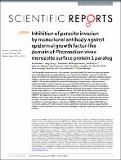Files in this item
Inhibition of parasite invasion by monoclonal antibody against epidermal growth factor-like domain of Plasmodium vivax merozoite surface protein 1 paralog
Item metadata
| dc.contributor.author | Han, Jin-Hee | |
| dc.contributor.author | Cheng, Yang | |
| dc.contributor.author | Muh, Fauzi | |
| dc.contributor.author | Ahmed, Md Atique | |
| dc.contributor.author | Cho, Jee-Sun | |
| dc.contributor.author | Nyunt, Myat Htut | |
| dc.contributor.author | Jeon, Hye-Yoon | |
| dc.contributor.author | Ha, Kwon-Soo | |
| dc.contributor.author | Na, Sunghun | |
| dc.contributor.author | Park, Won Sun | |
| dc.contributor.author | Hong, Seok-Ho | |
| dc.contributor.author | Shin, Ho-Joon | |
| dc.contributor.author | Russell, Bruce | |
| dc.contributor.author | Han, Eun-Taek | |
| dc.date.accessioned | 2019-07-17T15:30:04Z | |
| dc.date.available | 2019-07-17T15:30:04Z | |
| dc.date.issued | 2019-03-07 | |
| dc.identifier | 259651278 | |
| dc.identifier | 2b49caa4-7d3f-4c73-bc0f-166d4327a37d | |
| dc.identifier | 000460508600136 | |
| dc.identifier | 85062621236 | |
| dc.identifier.citation | Han , J-H , Cheng , Y , Muh , F , Ahmed , M A , Cho , J-S , Nyunt , M H , Jeon , H-Y , Ha , K-S , Na , S , Park , W S , Hong , S-H , Shin , H-J , Russell , B & Han , E-T 2019 , ' Inhibition of parasite invasion by monoclonal antibody against epidermal growth factor-like domain of Plasmodium vivax merozoite surface protein 1 paralog ' , Scientific Reports , vol. 9 , 3906 . https://doi.org/10.1038/s41598-019-40321-2 | en |
| dc.identifier.issn | 2045-2322 | |
| dc.identifier.other | ORCID: /0000-0002-3966-9110/work/59698776 | |
| dc.identifier.uri | https://hdl.handle.net/10023/18115 | |
| dc.description.abstract | The Plasmodium vivax merozoite surface protein 1 paralog (PvMSP1P), which has epidermal growth factor (EGF)-like domains, was identified as a novel erythrocyte adhesive molecule. This EGF-like domain (PvMSP1P-19) elicited high level of acquired immune response in patients. Antibodies against PvMSP1P significantly reduced erythrocyte adhesion activity to its unknown receptor. To determine PvMSP1P-19-specific antibody function and B-cell epitopes in vivax patients, five monoclonal antibodies (mAbs) and 18-mer peptides were generated. The mAb functions were determined by erythrocyte-binding inhibition assay and invasion inhibition assay with P. knowlesi. B-cell epitopes of PvMSP1P-19 domains were evaluated by peptide microarray. The pvmsp1p-19 sequences showed limited polymorphism in P. vivax worldwide isolates. The 1BH9-A10 showed erythrocyte binding inhibitory by interaction with the N-terminus of PvMSP1P-19, while this mAb failed to recognize PkMSP1P-19 suggesting the species-specific for P. vivax. Other mAbs showed cross-reactivity with PkMSP1P-19. Among them, the 2AF4-A2 and 2AF4-A6 mAb significantly reduced parasite invasion through C-terminal recognition. The linear B-cell epitope in naturally exposed P. vivax patient was identified at three linear epitopes. In this study, PvMSP1P-19 N-terminal-specific 1BH9-A10 and C-terminal-specific 2AF4 mAbs showed functional activity for epitope recognition suggesting that PvMSP1P may be useful for vaccine development strategy for specific single epitope to prevent P. vivax invasion. | |
| dc.format.extent | 11 | |
| dc.format.extent | 5747778 | |
| dc.language.iso | eng | |
| dc.relation.ispartof | Scientific Reports | en |
| dc.subject | QH301 Biology | en |
| dc.subject | RC Internal medicine | en |
| dc.subject | NDAS | en |
| dc.subject | SDG 3 - Good Health and Well-being | en |
| dc.subject.lcc | QH301 | en |
| dc.subject.lcc | RC | en |
| dc.title | Inhibition of parasite invasion by monoclonal antibody against epidermal growth factor-like domain of Plasmodium vivax merozoite surface protein 1 paralog | en |
| dc.type | Journal article | en |
| dc.contributor.institution | University of St Andrews. School of Medicine | en |
| dc.identifier.doi | https://doi.org/10.1038/s41598-019-40321-2 | |
| dc.description.status | Peer reviewed | en |
This item appears in the following Collection(s)
Items in the St Andrews Research Repository are protected by copyright, with all rights reserved, unless otherwise indicated.

